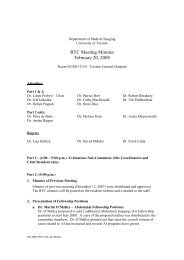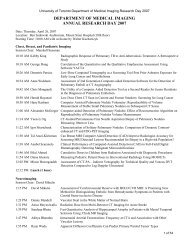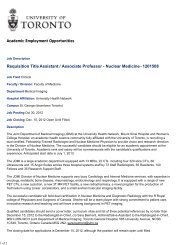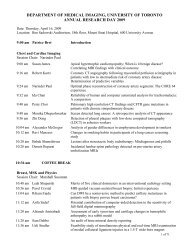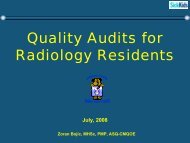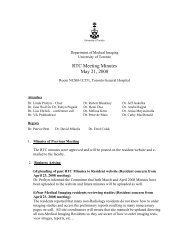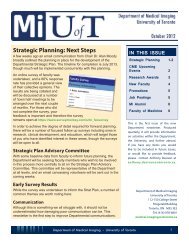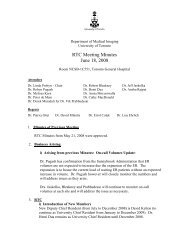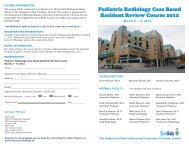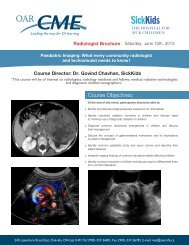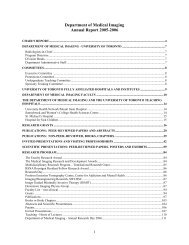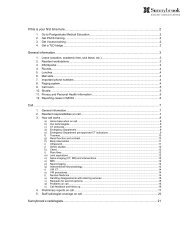CT Imaging of Acute Bowel Ischemia and Infarction - Department of ...
CT Imaging of Acute Bowel Ischemia and Infarction - Department of ...
CT Imaging of Acute Bowel Ischemia and Infarction - Department of ...
You also want an ePaper? Increase the reach of your titles
YUMPU automatically turns print PDFs into web optimized ePapers that Google loves.
<strong>CT</strong> <strong>Imaging</strong> <strong>of</strong> <strong>Acute</strong> <strong>Bowel</strong><br />
<strong>Ischemia</strong> <strong>and</strong> <strong>Infarction</strong><br />
R<strong>and</strong>y Fanous<br />
University <strong>of</strong> Toronto<br />
PGY3 Radiology
Outline<br />
• Anatomy<br />
– Vascular supply <strong>of</strong> bowel<br />
• Pathology<br />
– Stages<br />
– Contributing factors<br />
– Etiologies<br />
• <strong>CT</strong><br />
– Technique<br />
– Findings<br />
• Cases
Anatomy<br />
Vascular Supply <strong>of</strong> <strong>Bowel</strong>: Arterial<br />
• 1. Celiac = distal esophagus to descending duodenum<br />
– GDA (first branch <strong>of</strong> CHA) = anastomotic connections b/w celiac axis <strong>and</strong> SMA<br />
• 2. SMA = transverse duodenum to splenic flexure<br />
– Marginal artery <strong>of</strong> Drummond/ arcade <strong>of</strong> Riolan = anastomotic connections b/w<br />
SMA <strong>and</strong> IMA<br />
• 3. IMA = splenic flexure to rectum<br />
– Anastomotic connections to lumbar arteries (<strong>of</strong>f abdominal aorta) <strong>and</strong> internal<br />
iliacs<br />
• Watershed areas:<br />
– Splenic flexure<br />
– Ileocecal junction<br />
– Rectosigmoid junction
Anatomy<br />
Vascular Supply <strong>of</strong> <strong>Bowel</strong>: Arterial<br />
• 1. Celiac = distal esophagus to descending duodenum<br />
– GDA (first branch <strong>of</strong> CHA) = anastomotic connections b/w celiac axis <strong>and</strong> SMA<br />
• 2. SMA = transverse duodenum to splenic flexure<br />
– Marginal artery <strong>of</strong> Drummond/ arcade <strong>of</strong> Riolan = anastomotic connections b/w<br />
SMA <strong>and</strong> IMA Distribution provides clues to etiology…<br />
• 3. IMA = splenic flexure to rectum<br />
(b) SMA = jejunum, ileum, ascending, transverse<br />
– Anastomotic connections to lumbar arteries (<strong>of</strong>f abdominal aorta) <strong>and</strong> internal<br />
(c) IMA = descending (rectum spared)<br />
iliacs<br />
• Watershed areas:<br />
– Splenic flexure<br />
– Ileocecal junction<br />
– Rectosigmoid junction<br />
A. Vascular territories<br />
(a) Celiac = duodenum<br />
B. Watershed territories
Anatomy<br />
Vascular Supply <strong>of</strong> <strong>Bowel</strong>: Venous<br />
• SMV <strong>and</strong> IMV parallel the corresponding arteries <strong>and</strong> their drainage<br />
• IMV drains into splenic vein; splenic vein <strong>and</strong> SMV form portal<br />
confluence<br />
• Extensive anastomotic connections b/w mesenteric veins <strong>and</strong><br />
systemic venous circulation<br />
<strong>Bowel</strong> is highly vascularized with extensive collaterals<br />
(small >> large)
Anatomy<br />
Vascular Supply <strong>of</strong> <strong>Bowel</strong>: Blood Flow<br />
• Percentage <strong>of</strong> cardiac output received by bowel…<br />
– (a) Normal circumstances = 20%<br />
– (b) Post-pr<strong>and</strong>ial (splanchnic auto-regulation) = 35%<br />
– (c) Sympathetic stress response = 10%<br />
• Proportion <strong>of</strong> arterial blood to bowel wall…<br />
– 2/3 = mucosa (i.e. susceptible to ischemia)<br />
– 1/3 = remainder <strong>of</strong> the mural layers<br />
Ex. Shock = high-risk group<br />
(i.e. low flow state + stress response)
Pathology<br />
<strong>Ischemia</strong> <strong>and</strong> <strong>Infarction</strong>: Stages<br />
• 1 = mucosal ischemia<br />
– aka ischemic enteritis/ colitis<br />
– Reversible mucosal erosions <strong>and</strong> ulcerations<br />
• 2 = submucosal/ muscularis ischemia<br />
– Partial mural necrosis with possible repair +/- residual fibrotic strictures<br />
• 3 = transmural ischemia<br />
– aka bowel infarction<br />
– Non-reversible transmural gangrenous necrosis
Pathology<br />
<strong>Ischemia</strong> <strong>and</strong> <strong>Infarction</strong>: Contributing Factors<br />
• 1 = mucosal ischemia<br />
– aka ischemic enteritis/ colitis<br />
– Reversible mucosal erosions <strong>and</strong> ulcerations<br />
Important to realize that acute bowel<br />
ischemia does NOT refer to a single<br />
– Partial mural necrosis entity, with but possible rather repair a spectrum +/- residual <strong>of</strong> disease! fibrotic strictures<br />
• 2 = submucosal/ muscularis ischemia<br />
• 3 = transmural ischemia<br />
– aka bowel infarction<br />
– Non-reversible transmural gangrenous necrosis<br />
• Post-ischemic inflammatory response<br />
– i.e. release <strong>of</strong> a myriad <strong>of</strong> cytokines<br />
– Contributes to necrosis <strong>and</strong> further compromises mucosal integrity<br />
• Super-infection (esp. colon)<br />
– Translocation <strong>of</strong> intra-luminal bacteria, leading to mural infection, bacteremia <strong>and</strong><br />
sepsis (high mortality)
Pathology<br />
Etiologies<br />
1. Occlusive (75%):<br />
Arterial (thromboembolism)<br />
2. Non-occlusive (25%):<br />
Venous (bowel obstruction)<br />
• Occlusive (75%)<br />
– Mesenteric arterial (90%)<br />
• Ex. Thromboembolism (atrial fibrillation, aortic), mesenteric thrombosis, dissection etc.<br />
– Mesenteric venous (10%)<br />
• Ex. Neoplasm, infection, hypercoagubility (polycythemia, sickle cell, antithrombin III, protein C/S, oral<br />
contraceptives) etc.<br />
• Non-occlusive (25%)<br />
– Mechanical (bowel obstruction)<br />
• (a) Strangulation <strong>of</strong> mesenteric veins<br />
• (b) Over-distension with subsequent compromise <strong>of</strong> the local mucosal microcirculation<br />
– Hypoperfusion/ Vasospasm<br />
• Ex. Shock (hemorrhagic, septic, cardiogenic), severe dehydration, IVDU, pheochromocytoma, familial<br />
dysautonomia etc.<br />
– Inflammatory<br />
• Ex. Pancreatitis, appendicitis, diverticulitis, peritonitis etc.<br />
– Vasculopathy<br />
• Ex. Vasculitis (i.e. young patients, unusual sites), diabetic vasculopathy, fibromuscular dysplasia etc.<br />
– Others<br />
• Ex. XRT, chemotherapy, immunosuppression, corrosive injury etc.
Pathology<br />
Etiologies: Occlusive<br />
IMA atherosclerosis
Pathology<br />
Etiologies: Occlusive<br />
SMA thromboembolism
Pathology<br />
Etiologies: Occlusive<br />
SMA Cholesterol embolus
Pathology<br />
Etiologies: Occlusive<br />
Aortic stent occlusion <strong>of</strong> IMA
Pathology<br />
Etiologies: Occlusive<br />
Polycythemia ruba vera
Pathology<br />
Etiologies: Non-occlusive<br />
Cardiogenic shock
Pathology<br />
Etiologies: Non-occlusive<br />
Lupus
<strong>CT</strong><br />
Technique: Ischemic <strong>Bowel</strong> Protocol<br />
3 Types <strong>of</strong> contrast<br />
(a) IV (150 cc via mechanical injector at a rate <strong>of</strong> 2-4 ml/sec)<br />
(b) Oral<br />
(c) Rectal<br />
NB: <strong>Bowel</strong> distension (i.e. assess bowel wall thickness)<br />
NB: Positive vs. negative contrast Positive contrast indicated in suspected bowel obstruction <strong>and</strong> advantageous for delineation <strong>of</strong><br />
inner mural layer in setting <strong>of</strong> hypoattenuating mucosa. Otherwise, negative contrast allows optimal delineation <strong>of</strong> mural layers.<br />
3 Phases<br />
(a) Unenhanced<br />
•Differentiating hyperattenuating bowel wall caused by hemorrhage from that caused by hyperperfusion<br />
•Background atherosclerotic disease<br />
•Hyperattenuating intravascular clot<br />
(b) Arterial (30 sec)<br />
•Arterial occlusion<br />
(c) Portovenous (90 sec)<br />
•Venous occlusion<br />
•Assessment <strong>of</strong> the remainder <strong>of</strong> the organs<br />
Triple contrast<br />
Triple phased<br />
Triple planar<br />
3 Planes<br />
(a) Axial<br />
(b) Coronal<br />
(c) Sagittal
<strong>CT</strong><br />
Findings: Spectrum<br />
• Wide range <strong>of</strong> <strong>CT</strong> findings, as expected given the…<br />
– range <strong>of</strong> clinical manifestations<br />
– range <strong>of</strong> severity<br />
– range <strong>of</strong> underlying etiologies<br />
– +/- intramural hemorrhage<br />
– +/- superinfection<br />
Example:<br />
Diffuse vs. Segmental<br />
<strong>Bowel</strong> wall thickening vs. thinning<br />
<strong>Bowel</strong> wall hypoattenuation vs. hyperattenuation<br />
Mucosal hyperenhancement vs. no hyperenhancement
<strong>CT</strong><br />
Findings: Approach<br />
• Distribution<br />
– Diffuse<br />
– Segmental<br />
1. Distribution<br />
2. <strong>Ischemia</strong> = wall thickening, fluid, air<br />
3. <strong>Infarction</strong> = dilatation, wall thinning, AFL<br />
4. Perforation<br />
• <strong>Ischemia</strong><br />
– <strong>Bowel</strong> wall thickening = hypo vs. hyperattenuating; differential wall enhancement<br />
– Fluid = fat str<strong>and</strong>ing, mesenteric edema, ascites<br />
– Air = pneumotosis, portomesenteric venous gas<br />
• <strong>Infarction</strong><br />
– Dilatation<br />
– <strong>Bowel</strong> wall thinning<br />
– Fluid-filled loops/ AFLs<br />
• Perforation<br />
– Pneumoperitoneum<br />
– Intralumenal contrast extravasation<br />
– Abscess<br />
– Peritonitis
<strong>CT</strong><br />
Findings: Distribution<br />
• i.e. may provide clues to etiology<br />
• (a) Diffuse<br />
• (b) Segmental<br />
– Vascular territories<br />
– Watershed areas
<strong>CT</strong><br />
Findings: <strong>Bowel</strong> Thickening<br />
• s/t mural edema, hemorrhage, superinfection<br />
• Most SN, least SP (for ischemia, NOT infarction)<br />
• Range <strong>of</strong> SN = 26-96%<br />
– (a) ischemic colitis = 94%<br />
– (b) mesenteric ischemia = 80%<br />
– (c) bowel infarction = 26-38%<br />
• Occlusive = non-occlusive<br />
• Venous >> Arterial<br />
• (a) Hypoattenuating vs. hyperattenuating<br />
– Hypoattenuation = edema<br />
– Hyperattenuation = hemorrhage<br />
• (b) Differential bowel wall enhancement<br />
– i.e. mucosal hyperenhancement<br />
– s/t hyperemia (i.e. reperfusion or superinfection)<br />
– SN 33% SP 71%<br />
– Produces target sign
<strong>CT</strong><br />
Findings: <strong>Bowel</strong> Thickening<br />
Edema<br />
Hemorrhage<br />
Bacterial superinfection<br />
Target sign
<strong>CT</strong><br />
Findings: Fluid<br />
• (a) Fat str<strong>and</strong>ing (mesenteric/ pericolonic)<br />
• (b) Mesenteric edema<br />
• (c) Ascites<br />
• NB: study <strong>of</strong> SN <strong>and</strong> SP in non-occlusive venous ischemia (i.e.<br />
venous congestion from bowel obstruction)<br />
– (a) Str<strong>and</strong>ing = SN 58%, SP 79%<br />
– (b) Edema = SN 88%, SP 90%<br />
– (c) Ascites = SN 75%, SP 94%<br />
– NB: 2+ = SP 94%
<strong>CT</strong><br />
Findings: Air<br />
• s/t dissection <strong>of</strong> intra-luminal air s/t loss <strong>of</strong> mucosal integrity<br />
• SP approach 100%<br />
• (a) Pneumotosis<br />
– Non-dependent locules<br />
– Dissecting wall<br />
• (b) Portomesenteric venous gas<br />
– Periphery <strong>of</strong> liver<br />
– Mesenteric vessels
<strong>CT</strong><br />
Findings: Air<br />
Pneumotosis<br />
Portal venous gas<br />
Mesenteric venous gas
<strong>CT</strong><br />
Findings: <strong>Infarction</strong><br />
• (a) <strong>Bowel</strong> dilatation<br />
• (b) <strong>Bowel</strong> wall thinning (i.e. paper thin)<br />
– s/t destruction <strong>of</strong> intramural nerves <strong>and</strong> muscles<br />
• (c) AFLs/ fluid-filled (i.e. gasless bowel)<br />
– Fluid exudation into the lumen<br />
• NB: SN <strong>of</strong> dilatation <strong>and</strong>/or AFL = 56-91% (vs. 40% in ischemia)
<strong>CT</strong><br />
Findings: Complications<br />
• Perforation<br />
– Pneumoperitoneum<br />
– Intralumenal contrast extravasation<br />
– Abscess<br />
– Peritonitis
Cases<br />
Case #1
Cases<br />
Case #1: Large bowel ischemia
Cases<br />
Case #2
Cases<br />
Case #2: Large bowel ischemia
Cases<br />
Case #3
Cases<br />
Case #3: Small bowel <strong>Ischemia</strong>
Cases<br />
Case #4
Cases<br />
Case #4: Small <strong>and</strong> large bowel infarction
Cases<br />
Case #5
Cases<br />
Case #5: Small bowel obstruction with ischemia <strong>and</strong> perforation
References<br />
• Wiesner W, et al. <strong>CT</strong> <strong>of</strong> acute bowel ischemia. Radiology 2003;<br />
226:635-650<br />
• Sung RE, et al. <strong>CT</strong> <strong>and</strong> MR imaging findings <strong>of</strong> bowel ischemia from<br />
various causes. Radiographics 200; 20:29-42
Cases<br />
1. 2678623 = large bowel ischemia<br />
1. 804200566 = large bowel ischemia<br />
2. 2319634 = small bowel ischemia<br />
3. 6270051 = small <strong>and</strong> large bowel infarction<br />
4. 3259333 = small bowel obstruction with ischemia <strong>and</strong> perforation<br />
5. 800131666 = ischemic small bowel post-laparotomy that is normal at surgery




